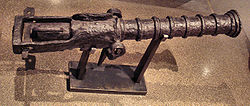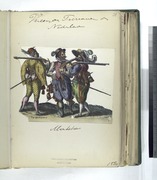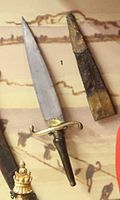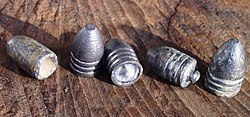Top Qs
Timeline
Chat
Perspective
Timeline of the gunpowder age
From Wikipedia, the free encyclopedia
Remove ads
This is a timeline of the history of gunpowder and related topics such as weapons, warfare, and industrial applications. The timeline covers the history of gunpowder from the first hints of its origin as a Taoist alchemical product in China until its replacement by smokeless powder in the late 19th century (from 1884 to the present day).
Pre-gunpowder formula
Major developments: Earliest stage of gunpowder development. Mentions of gunpowder ingredients and their uses in conjunction with each other.
Remove ads
9th century
Major developments: Earliest definite references to a gunpowder formula and awareness of its danger.
Remove ads
10th century
Summarize
Perspective
Major developments: Gunpowder is utilized in Chinese warfare and an assortment of gunpowder weapons appear. Fire arrows utilizing gunpowder as an incendiary appear in the early 900s and possibly rocket arrows as well by the end of the century. The gunpowder slow match is used for igniting flame throwers. The ancestor of firearms, the fire lance, also appears, but its usage in the 10th century is uncertain and no textual evidence for it exists during this period.
- A flamethrower from the Wujing Zongyao, supposedly used the gunpowder slow match
- An arrow strapped with gunpowder ready to be shot from a bow. From the Huolongjing
- A fire arrow from the Wubei Zhi
- Rocket arrows from the Huolongjing.
- Depiction of fire arrows known as "divine engine arrows" (shen ji jian 神機箭) from the Wubei Zhi.
11th century
Summarize
Perspective
Major developments: The chemical formula for gunpowder is recorded in the Wujing Zongyao by 1044. Bombs appear in the early 11th century. Gunpowder becomes more common in the Song dynasty and production of gunpowder weapons is systematized. The Song court restricts trade of gunpowder ingredients with the Liao and Western Xia dynasties.
- Earliest known written formula for gunpowder, from the Wujing Zongyao of 1044 AD.
- An expendable bird carrying an incendiary receptacle around its neck. From the Wujing Zongyao.
- An 'igniter fire ball' and 'barbed fire ball' from the Wujing Zongyao.
- A thunderclap bomb as depicted in the Wujing Zongyao.
- Gunpowder pot and caltrops from the Yuan dynasty.
- Depiction of a' wind-and-dust bomb' (feng chen pao) from the Huolongjing.
Remove ads
12th century
Summarize
Perspective
Major developments: Gunpowder fireworks are mentioned. Ships are equipped with trebuchets for hurling bombs. Earliest recorded usage of gunpowder artillery in ship to ship combat, first mention of the fire lance in battle, and the earliest possible depiction of a cannon appears.
- A fire lance from the Huolongjing.
- A double barreled fire lance from the Huolongjing. Supposedly they fired in succession, and the second one is lit automatically after the first barrel finishes firing.
Remove ads
13th century
Summarize
Perspective
Major developments: Bomb shells gain an iron casing. Fire lances are equipped with projectiles and reusable iron barrels. Rockets are used in warfare. "Fire emitting tubes" are produced in the Song dynasty by the mid-13th century and hand cannons are recorded to have been used in battle by the Yuan dynasty in 1287. The earliest extant cannons appear in China. The Mongols spread gunpowder weaponry to Japan, Southeast Asia, and possibly the Middle East as well as Europe. Europe and India both acquire gunpowder by the end of the century, but only in the Middle East are gunpowder weapons mentioned in any detail.
- The 'phalanx-charging fire-gourd' forgoes the spearhead and relies solely on the force of gunpowder and projectiles. From the Huolongjing.
- An illustration of a 'flying-cloud thunderclap-eruptor,' a cannon firing thunderclap bombs, from the Huolongjing.
- A 'poison fog divine smoke eruptor' (du wu shen yan pao) as depicted in the Huolongjing. Small shells emitting poisonous smoke are fired.
- Cannon with trunnions, Yuan Dynasty (1271–1368)
- Stone cannon balls unearthed in Shangdu, Yuan Dynasty (1271–1368)
- Yuan dynasty bombs, known in Japanese as Tetsuhau (iron bomb), or in Chinese as Zhentianlei (thunder crash bomb), dated to the Mongol invasions of Japan (1271–1284).
Remove ads
14th century
Summarize
Perspective
Major developments: Chinese gunpowder weaponry continues to advance with the development of one-piece cast iron cannons, accompanying carriages, and the addition of land mines, naval mines and rocket launchers. Earliest recorded instance of volley fire with gunpowder weaponry, by the Ming dynasty. The rest of the world catches up quickly and most of Eurasia acquires gunpowder weapons by the second half of the 14th century. Cannon development in Europe progresses rapidly and by 1374, cannons in Europe are able to breach a city wall for the first time. Breech loading cannons appear in Europe.
- A "nest of bees" (yi wo feng 一窩蜂) arrow rocket launcher as depicted in the Wubei Zhi.
- A 'divine bone dissolving fire oil bomb' (lan gu huo you shen pao) from the Huolongjing.
- A bronze "thousand ball thunder cannon" from the Huolongjing.
- The 'self-tripped trespass land mine' (zi fan pao) from the Huolongjing.
- Naval mine system known as the 'marine dragon-king' (shui di long wang pao) from the Huolongjing.
- Oldest known European depiction of a firearm from De Nobilitatibus Sapientii Et Prudentiis Regum by Walter de Milemete (1326).
- Battle of Nicopolis 1398
Remove ads
15th century
Summarize
Perspective
Major developments: Large-calibre artillery weighing several thousand kg are produced in Europe during the early 15th century and spread to the Ottoman Empire. Modifiable two wheeled gun carts known as limbers and caissons appear, greatly improving the mobility of artillery. The matchlock arquebus, the first firearm with a trigger mechanism, appears in Europe by 1475. Rifled barrels also appear in the late 15th century. The term musket is used for the first time in 1499. Rocket launchers are used in battle by the Ming dynasty and the Korean kingdom of Joseon develops a mobile rocket launcher vehicle called the hwacha. Chinese style bombs are used in Japan by 1468 at the latest.
- Breech loading cannon, 1410.
- Faule Magd ("Lazy Maid"), a medieval cannon from ca. 1410–1430.
- Mons Meg, a medieval Bombard (weapon) built in 1449.
- The bronze Great Turkish Bombard, used by the Ottoman Empire in the siege of Constantinople in 1453.
- Early arquebuses prior to the matchlock were just hand cannons with a hook
- A serpentine matchlock mechanism
- A hwacha assembly and disassembly illustration from the Gukjo Orye Seorye, 1474
Remove ads
16th century
Summarize
Perspective
Major developments: Matchlock firearms spread throughout Eurasia, reaching China and Japan by the mid-16th century. The volley fire technique is implemented using matchlock firearms by the Ottomans, Ming dynasty, and Dutch Republic by the end of the century. The arquebus is replaced by its heavier variant called the musket to combat heavily armoured troops. "Musket" becomes the dominant term for all shoulder arms fireweapons until the mid-19th century. The wheellock and flintlock trigger mechanisms are invented. Pistols and revolvers both appear during this period. Ottoman troops attach bayonets to their firearms. Both Europe and China develop handheld breech loading firearms. The star fort spreads across Europe in response to increasing effectiveness of siege artillery. The Ming dynasty uses gunpowder for hydraulic engineering.
Remove ads
17th century
Summarize
Perspective
Major developments: Bayonets spread across Eurasia. A paper cartridge is introduced by Gustavus Adolphus. Rifles are used for war by Denmark. A ship of the line carrying 60 to 120 cannons appears in Europe. Samuel Pepys' diary mentions a machine gun like pistol. The "true" flintlock replaces the snaphance flintlock in Europe by the end of the 17th century. Both China and Japan reject the flintlock and the Mughal Empire only uses it in limited quantities. Gunpowder is used for mining in Europe.
- Sovereign of the Seas, 102 guns, 1637.
- HMS Royal Charles (1673), 100 gun
- HMS Britannia (1682), 100 guns
- A breech loading matchlock with a plug bayonet from the Binglu, 1606.
- Plug bayonet from the 1650s
Remove ads
18th century
Summarize
Perspective
Major developments: Flintlocks completely displace matchlock firearms in Europe both on land and at sea. Sir William Congreve, 1st Baronet discovers "cylinder powder", gunpowder produced using charcoal in iron cylinders, which is twice as powerful as traditional gunpowder and less likely to spoil. He also invents block trail carriages, the most advanced artillery transport of the time. James Puckle invents a breechloader flintlock capable of firing 63 shots in seven minutes. The Kingdom of Mysore deploys iron cased rockets known as Mysorean rockets.
- Vertical cannon drilling
- Benjamin Robins describes the ballistic pendulum in the New Principles of Gunnery
- Flier for Puckle gun of 1718 showing various cylinders for use with round and square bullets.
- Late 18th century carronade
- Tipu Sultan soldier using a Mysorean rocket as a flag staff
- Illustration of Mysorean rockets used by the troops of Tipu Sultan
Remove ads
19th century
Summarize
Perspective
Major developments: Sir William Congreve, 2nd Baronet develops the Congreve rockets based on Mysorean rockets and British forces successfully deploy them against Copenhagen. Joshua Shaw invents percussion caps which replace the flintlock trigger mechanism. Claude-Étienne Minié invents the Minié ball, making rifles a viable military firearm, ending the era of smoothbore muskets. Subsequently rifles are deployed in the Crimean War with resounding success. Benjamin Tyler Henry invents the Henry rifle, the first reliable repeating rifle. Richard Jordan Gatling invents the Gatling gun, capable of firing 200 cartridges in a minute. Hiram Maxim invents the Maxim gun, the first single-barreled machine gun. Both China and Europe start using cast iron molds for casting cannons. Alfred Nobel invents dynamite, the first stable explosive stronger than gunpowder. Smokeless powder is invented and replaces the traditional "black powder" in Europe by the end of the century.
- The Henry rifle and Winchester rifle
20th century
Major developments: Smokeless powder replaces traditional "black powder" across the globe, ending the gunpowder age.
See also
Citations
References
Wikiwand - on
Seamless Wikipedia browsing. On steroids.
Remove ads





























































